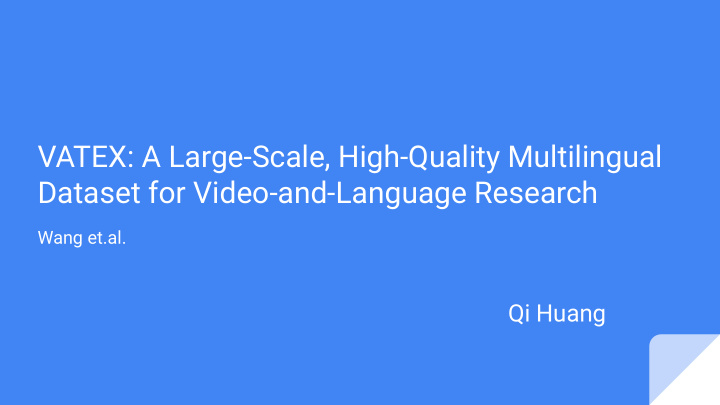



VATEX: A Large-Scale, High-Quality Multilingual Dataset for Video-and-Language Research Wang et.al. Qi Huang
Outline 1. Motivation 2. VATEX Dataset Overview 3. Multilingual Video Captioning 4. Video-guided Machine Translation 5. Examples 6. Critique & Future Work
Motivation ● Previous video description datasets are monolingual, relatively small , with restricted domains and linguistically simple . They only enable video description tasks that are ● single-modality on both input and output sides (input: video frames; output: text) Can we have better video description datasets that are ● multilingual, large, open domain and linguistically complex? ● Can we design video description tasks that has multi-modal input/output ?
VATEX VATEX achieves all of that 41, 250 videos ● 825, 000 captions ● ● Parallel description in English and Chinese ● Open domain, 600 classes Many more.. ●
Comparison Comparing to datasets used in seq2seq video2text: 10x increase in # ● sentences ● Open domains v.s. only movie clip
Comparison Comparing to MSR-VTT: Unique sentence ● ensured with human effort ● Multilingual vs monolingual Linguistically more ● complicated (n-grams, POS tags..)
Comparison Comparing to MSR-VTT: Captions are uniformly ● more complex in caption length, # of unique token
Data Collection ● Categorization and a large part of videos reused from Kinetics-600 dataset English caption collection: ● ○ Experienced, high approval rate AMT workers from English-speaking countries ○ Short, repeated, irrelevant and sensitive word captions are filtered out ○ 412, 690 sentences with 2, 159 workers ● Chinese caption collection: Half of the captions are direct observation of videos (5/10) ○ ○ Another half are Chinese translation of English captions, bootstrap by 3 commercial machine translation services, cross-approved by co-workers
Multilingual Video Captioning Problem Setting: given sampled frames from video streams, output captions for each video stream sample Baseline: Pretrained 3D CNN from I3D network to ● extract frame level features ● Bidirectional LSTM as Video Encoder ● LSTM with attention as caption decoder
Multilingual Video Captioning Multilingual Variants: 1. Shared Encoder 2. Shared Encoder-Decoder (word embedding are different for different languages)
Multilingual Video Captioning: Result ● Multilingual models consistently outperform baseline with reduced # parameters
Video-guided Machine Translation (VMT) Problem Setting: given sampled frames from video streams and captions in a source language, output captions in the target language In following up experiments, some noun/verbs in source captions are randomly masked to test whether video information can help model disambiguate unknown tokens
VMT: Model Baseline: Encoder-decoder model without video information. Attend only to source caption features Variant: ● Video information as a average frame feature vector Video information as video encoder output ● Video information as attention over video encoder ● hidden states
VMT: Result ● Actively attend to video information significantly boost MT performance over baseline -- language dynamics are used as a query to retrieve related video features VMT is able to recover ● missing information with the help of video context
Multilingual Video Captioning : an example Observation Base model and multilingual ● models all produce high-quality captions ● Information “women/girls” are preserved in base model for English, lost in shared enc-dec Perhaps “ 一群女子 “ never appears in the training corpus for Chinese captions Multilingual models encourage captions to converge, even at the cost of leaving out information.
VMT: example Observation: Masked noun: in Chinese ● translation, “a man” is corrected into “a band”. Probably “a man” is much more common in training corpus ● Disambiguate word: “cartwheel” is corrected from “making wheels” to “cartwheel” Video information can help reduce bias, disambiguate word meaning, and provide missing information
Critique & Future Work Highlights: High-quality large scale multilingual video description dataset ready for use ● ● Data collection process is rigorous and can serve as a reference for future dataset creation Data cross-validated by workers ○ ○ Eliminate repeated data Great visualization of linguistic properties of the dataset (histogram, type-caption curve, etc.) ○ ● Empirical success: Multilingual Video Caption: increase in performance and reduced parameters ○ ○ Video-guided Machine Translation: video information help correct exposure bias, disambiguate rare words, and provide missing information
Critique & Future Work What’s missing: ● Some questionable details: Average VI averages frame feature vector directly, while attention is on encoder hidden states -- fair ○ comparison? Multilingual video captioning with shared weight encoder/decode: what’s the training scheme? ○ Train English then Chinese? Iteratively? Will better training strategy benefit? How does swapping language embedding simple work? ○ Video-guided machine translation: visualize attention over video encoding? Vector encoding loss spatial information -- how does attention help if the key reference object appear in all frames? ● More experiments Video-guided machine translation: English to Chinese? ○ ○ Language model pretraining? Video encoding that retain spatial information? ○ ○ Since no metric is perfect -- test it with AREL learned reward? Future work ● ○ VMT looks like a really interesting task -- improve machine translation quality on even harder dataset? ○ Single video + multilingual caption => single caption + multichannel video -- better video encoding?
Recommend
More recommend